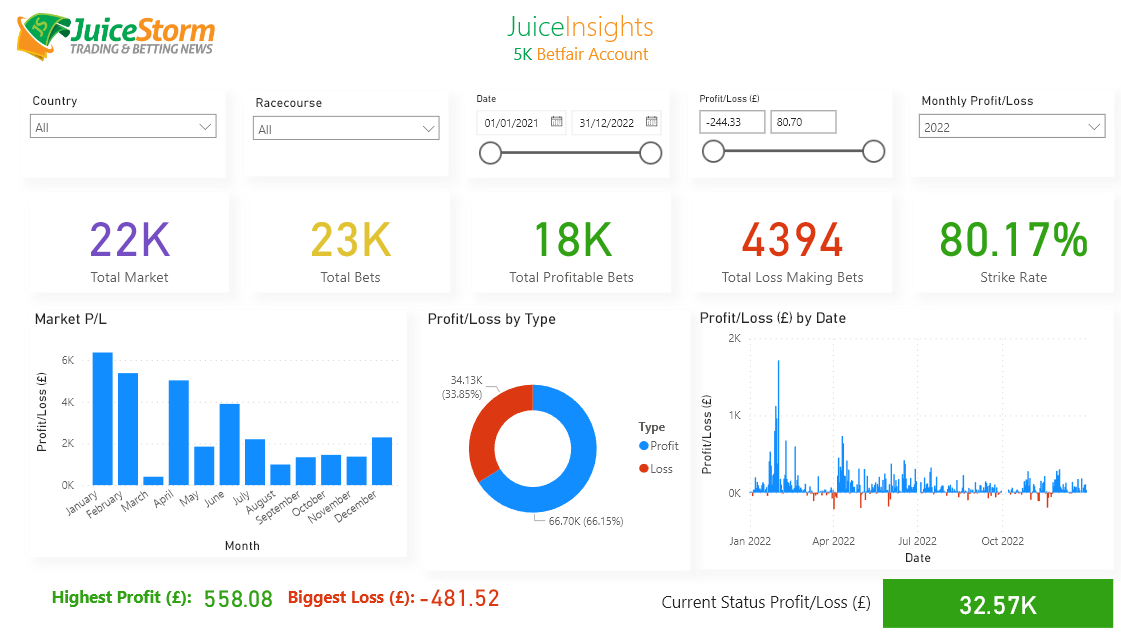Bet365 Horse & Greyhound Offers Pt 2
Part 2 – The Importance Of Odds
Part 3 – The Rolling Free-Bet Matching Spreadsheet.
Unlike conventional bet matching, because bet365 keep giving us free bets, even if our free bets win, we don’t configure our stake to guarantee the same profit. Instead, we over lay the runner, knowing that if it wins, we’ll get another free bet to compensate.
Now that that is out of the way, lets have a look at the effect of odds specific to these offers by plugging in some numbers. For the purposes of this exercise, assume these figures are for horse racing with minimum odds of 4/1 and we’ll ignore Betfair commission just to keep the numbers simple. Also, I’ll assume the back price is the same on Betfair as it is on bet365.
Let’s say we back a horse at the minimum odds of 5.00 for £50 (the maximum allowed by bet365 though we can stake up to £100 on the dogs). The lay odds on Betfair will be 5.10 which will give us a liability of £205. So, a losing runner will see us lose £50 from bet365 and win £50 on Betfair, i.e. net £0 (ignoring commission). However, a winning pick will see us lose £205 on Betfair and win £200 from bet365, i.e. a net loss of £5 but we’ll have a free bet in hand which will easily recover that £5.
Now, let’s look at the same scenario but with back/lay odds of 10.0/10.5. Once again in the event of a losing pick we’ll have a net return of £0 (ignoring commission). If the pick wins though, we’ll lose £475 on Betfair and win £450 from bet365 for a net loss of £25. Granted, we’ll have a free bet to come, but it’s got to recover £25 as opposed to £5 in the previous example.
So, when placing your NON-FREE bet, it is best to go for odds as low as possible that meet the minimum odds criteria laid down by bet365. Failure to do so means that any subsequent free bet may well struggle to recoup the losses from the previous race, far less make a profit.
In the case of the free bet, conventional matched betting suggests that when the free bet is not returned, we should look to bet on something with high odds. However, when doing the bet365 offers, this isn’t so important as we are laying off differently. As mentioned earlier, conventional matched betting means we would lay off in such a way as to guarantee the same profit irrespective of the outcome – just as we do when ‘greening up’ while trading. With the bet365 offer though, we continue to overlay knowing that if our runner wins. we get another free bet.
There’s other reasons for keeping the qualifying bet odds low which I’ll go into shortly, however, there is one caveat that we should be aware of. Bet365 have minimum odds requirement for the qualifying bet. In the case of the horses, it is 5.00 with the greyhounds being much better at 3.00. Now, if our runner is involved in a dead heat, then the effective odds will be half of what we took. If those effective odds are less than the minimum qualifying requirement, bet365 will NOT give us a free bet. Fortunately, dead heats don’t happen that much in horse racing, though they are more frequent with the dogs. Still, it is something we should keep in mind.
Keeping the odds low is also important depending on the size of our bank. The higher the odds, the greater the funds required in our Betfair account to cover the liabilities. Ideally, to maximise the return from these offers, we want to use the maximum stake size allowed by bet365, i.e. £50 for the horses and £100 for the dogs. This obviously needs to be reflected in the sums available in each account. If we are able to do so, we should jump straight in with the maximum amounts, but we can obviously start smaller if funds are limited, but I digress…
Although the size of the odds is important for maximising our return, the SINGLE MOST IMPORTANT THING is to keep the size of the spread in odds to an absolute minimum. Specifically, make sure the lay odds are not too high compared to the back odds available on bet365. Keep in mind that, unlike trading where we would want to ‘green/red up’, the strategy here is to OVER lay. We want to create an unbalanced match so that we do not lose money when our runner loses but we are prepared to take a hit if our runner wins because we know that we’ll get a free bet which will recover that loss and put us in profit.
However, if the lay odds are too high and our runner wins, we may end up with a situation where any potential profit from the subsequent free bet will not be sufficient to recover that loss far less put us into profit. Even a difference of 1 tick can be detrimental at high odds. So here’s a general rule of thumb that may be of use:
If the lay odds are such that a winning runner will result in a net losing position of 75% of our stake, then look elsewhere.
Sometimes we have no choice but to go with the higher odds but there are ways to mitigate the liability if that happens. Ideally though, we are looking for lay odds around the same level of the back odds available on bet365. Even better, lay odds less than those obtained on bet365 will give us much more flexibility. Take a look at the following example:
Going back to our horse at the minimum odds of 5.00 on bet365, let’s assume we managed to lay it off on Betfair at odds of 4.80. For stakes of £50, we’ll have a liability of £190 on Betfair. So, a losing runner will see us lose £50 from bet365 and win £50 on Betfair, i.e. net £0 (again, ignoring commission). However, a winning pick will see you lose £190 on Betfair and win £200 from bet365, i.e. a net profit of £10 with the added bonus of a free bet to come.
Now, we could leave it at that and hope for a winner. Alternatively, that extra £10 gives us something extra to play with. For example, given that losers are easier to come by than winners, we could add a little extra to the lay so that we get a small profit on a loser as well as a winner. Or, we could increase the lay still further so that a winner still saw us go into the red knowing that we’d get a free bet to compensate. How you go about it is entirely up to you but one of my favourite ploys was to place an additional lay at lower odds in-running, thus maximising the benefit while reducing the liability in the event of a winner.
A couple of things I’ll mention before I draw this discussion to a close…
Get into the habit of looking through the card in advance. Because of the minimum odds required by bet365 and the impact high odds have, there may well be races being covered by the offer that have a very short priced favourite. By definition, the other runners will have high odds. This is particularly true on most of the SKY televised greyhound meetings today as these tend to be open races with a red hot favourite. We may want to leave those races alone. However, if we had a winning runner in the previous race, we have no choice but to get involved in the following race. Why? Because the free bet from bet365 MUST be used in the next race after a winner.
Also, keep in mind that there’s no need to do these in order. If you see a good odds spread on a runner in one of the races in the middle of the card, then take them. These offers work by you placing bets from your bet365 funds. If you have a winner, bet365 refund the stake back to your account, usually within an hour. So if you find a winner in one race, having already placed your bet in the next one, no matter.
As mentioned in the first part of this series, there’s many ways to go about these offers depending on your risk management and what you prefer. In part three, I’ll discuss how you can use the bet365 Rolling Free-Bet Matching spreadsheet I developed in order to put these strategies into action.
Alistair Hamilton
Part 1 – Introduction
Part 3 – The Rolling Free-Bet Matching Spreadsheet






Comments are closed, but trackbacks and pingbacks are open.